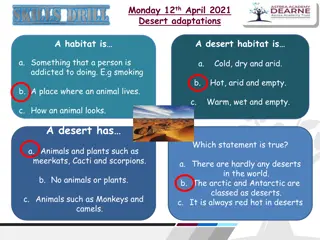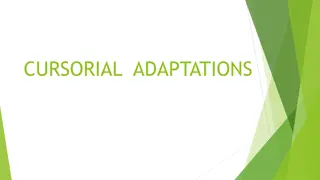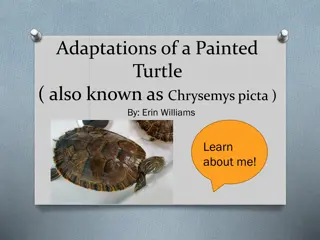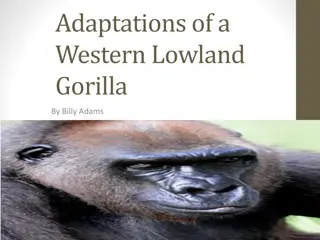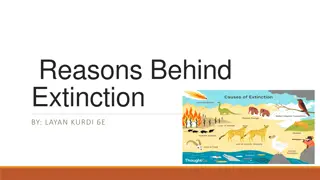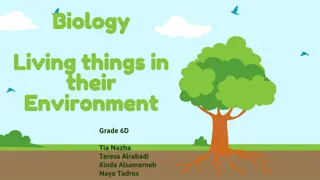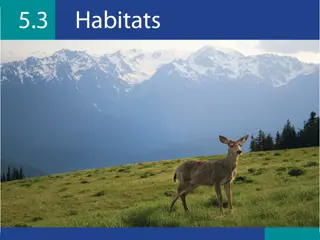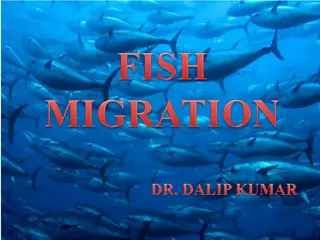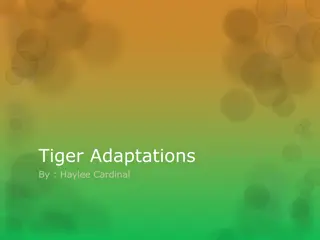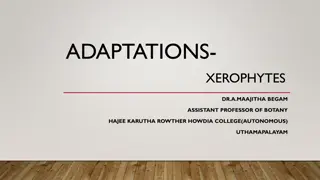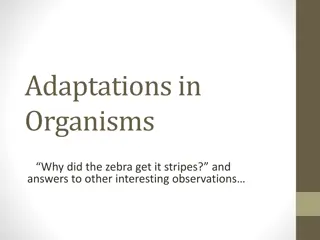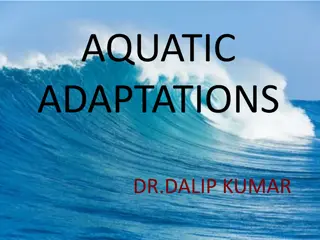Evolution of Film Adaptations: From Silent Cinema to Modern Innovations
The moving picture industry emerged in the 1890s, paving the way for adaptations of literary works in the early 1900s. With the advent of sound, a new era of adaptations began, leading to experiments and innovations in modern filmmaking. Adaptation is a process of adjusting and presenting a work in
8 views • 23 slides
Birds: Adaptations of Beaks and Feet for Survival
Explore the fascinating world of bird adaptations through the modification of beaks and feet. From tearing and piercing beaks to fruit-eating beaks, mud-probing beaks, fish-catching beaks, and wood chiselling beaks, discover how different bird species have evolved unique features to thrive in their
5 views • 29 slides
Exploring Seed Plant Diversity and Adaptations
Delve into the realm of seed plants, uncovering their unique adaptations for reproduction, their phylogeny with gymnosperms and angiosperms, and the diversity within gymnosperms such as conifers, cycads, gingkophytes, and gnetophytes. Discover the evolutionary success of seed plants through their wa
5 views • 23 slides
Modelling Estuarine Habitats in the Upper Sea Scheldt: Human-Induced Adaptations
Explore a research study on modelling estuarine habitats in the Upper Sea Scheldt under various human-induced channel and floodplain adaptations. The study examines the impact of interventions on habitat size, water quality, ecosystem, and more, providing insights into the future of the estuarine en
3 views • 13 slides
Designing a Sustainable Mars Habitat for Long-term Crew Stay
Design a Mars habitat for the first human crew that will be staying on Mars for several years. The habitat must include essential components such as sleeping quarters, restroom, exercise room, radiation shielding, food/water supply, entertainment, and ISRU technologies. Teams will research, create a
0 views • 7 slides
Adaptations in Helminth Parasites: Structural and Morphological Changes
Helminth parasites exhibit adaptations for successful living within hosts, involving structural modifications such as degeneration and new organ formation. Parasitism has evolved over time, leading to a dependent relationship between parasites and hosts. The adaptations in locomotory, digestive, and
1 views • 19 slides
Desert Adaptations: Animals and Habitat Survival
Habitats play a crucial role in the survival of animals, especially in harsh environments like deserts. Explore the unique adaptations of animals like camels and learn how they are perfectly suited to thrive in hot, arid conditions. Understanding these adaptations is key to appreciating the diversit
0 views • 16 slides
Adaptations of Cursorial Animals: Cheetah, Horse, and Musk Deer
Explore the cursorial adaptations of three distinct animals - the cheetah with its incredible speed, the horse designed for swift running, and the musk deer adapted for elusive movements. Learn about their habitats, unique characteristics, and specialized adaptations for survival in their environmen
0 views • 12 slides
Respiration in Mollusca: Adaptations to Different Habitats
Mollusca exhibit various modes of respiration depending on their habitat - aquatic, terrestrial, or amphibious. Different respiratory organs are modified accordingly, such as ctenidia or gills for aquatic species, pulmonary sac for aerial species, and mantle or integument for those lacking specific
0 views • 17 slides
Understanding Aquatic Adaptation in Animals
Aquatic adaptation refers to the changes in an animal's body organization to thrive in a water habitat. Vertebrates have evolved to lead partial or total aquatic lives, showcasing various adaptations. Water as a habitat offers a homogenous medium, stable conditions, and rich food resources. Aquatic
0 views • 9 slides
Amazing Adaptations of the Painted Turtle
Discover the incredible adaptations of the painted turtle, also known as Chrysemys picta. Surviving freezing ponds, hibernating without oxygen, and using its colorful shell for camouflage are just a few ways this unique turtle thrives in its environment. Learn how it climbs with its clawed feet and
0 views • 8 slides
Adaptations and Habitat of Western Lowland Gorillas
Discover the unique adaptations of Western Lowland Gorillas including their vegetarian diet, lifespan in the wild and captivity, human-like communication abilities, and their habitat in the African Tropics Secondary Forests. Learn about the importance of conservation efforts to protect these magnifi
0 views • 8 slides
Fascinating World of Hippos: Explore Their Habitat and Adaptations!
Delve into the intriguing world of hippos as we uncover their lifestyle, habitat, and unique adaptations. Discover how these majestic creatures thrive in Africa, their lazy reputation, and the mesmerizing aspects of their underwater life. From baby hippos bonding with their mothers to adult hippos f
1 views • 14 slides
Environmental Impacts of Fishing: Habitat Damage and Bycatch
Fishing can negatively impact the marine environment through habitat damage and bycatch. Habitat damage occurs when fishing gear harms delicate seafloor habitats where endangered species grow. Bycatch, or unwanted catch, involves unintentionally capturing marine species like whales, dolphins, and se
0 views • 4 slides
Impact of Habitat for Humanity Homeownership on Quality of Life
A study by Wilder Research on Habitat for Humanity homeowners in Minnesota reveals positive impacts on safety, health, education, social connectedness, family interaction, personal well-being, and economic situation. Results show improved quality of life, with high levels of satisfaction and safety
0 views • 13 slides
Challenges and Solutions in Harbor Herons Citizen Science Surveys
The Citizen Science Surveys regarding harbor herons face various challenges such as habitat assessments, effects of tides, distance issues, and discrepancies in data entry. Volunteer input, carefully crafted protocols, and maintaining contact with volunteers help in addressing these challenges. Solu
0 views • 29 slides
Threats to Wildlife Conservation: Understanding Extinction Causes
Animals face extinction due to genetic factors, habitat destruction, invasive species, global warming, hunting, and illegal trade. Black rhinos are critically endangered mainly due to poaching and habitat loss. Tree kangaroos and rockhopper penguins are also at risk due to habitat degradation and cl
0 views • 6 slides
Legal Analysis of Gopher Frog Habitat Determination
Professor Edward Richards from LSU Law School discusses the potential constitutional issues raised by the designation of critical habitat for the gopher frog. The analysis includes examining interstate commerce issues, regulatory takings, wetlands permitting under the CWA, and the proper designation
0 views • 11 slides
Exploring the Life Cycle and Habitat of a Grizzly Bear
Delve into the fascinating life cycle and habitat of grizzly bears, from their varied habitats encompassing grasslands, tundra, and more, to their adaptations, diet, and behavior such as eating berries, roots, fish, and even deer. Discover how grizzly bear cubs differ from adults and the aggressive
0 views • 8 slides
Fossorial Specimens: Mole and Caecilian Adaptations
Fossorial specimens, including the mole and caecilian, are uniquely adapted for subterranean burrowing. The mole, commonly known for its wedge-shaped head and reduced eyes, lives in tunnels and feeds on small worms and insects. On the other hand, the limbless caecilian, resembling a worm, thrives in
1 views • 25 slides
Tidal Waters Fish Habitat Assessment Choptank Framework Pilot Fish GIT Meeting January 2021
The Tidal Waters Fish Habitat Assessment Choptank Framework Pilot Fish GIT Meeting held in January 2021 discussed background, drivers, and the selection of the Choptank River as a candidate tributary. The project team, responsible parties, actions, and timeline for developing an analytical framework
0 views • 17 slides
Amazing Adaptations of Lions in the Wild
Lions have incredible adaptations that aid in their survival and hunting strategies. Their loose body skin, mane, eyes, muscled forelimbs, rough tongue, color, and more play crucial roles in their ability to thrive in their environment. Explore these fascinating adaptations through images and descri
0 views • 8 slides
The Fascinating Malayan Tapir: Habitat, Range, and Adaptations
The Malayan tapir, the largest of its kind, is uniquely adapted to its habitat in tropical lowland swamps, montane and hill forests. With its distinctive black and white color pattern for camouflage and a prehensile snout for feeding and communication, this species thrives in Myanmar, Thailand, Mala
0 views • 26 slides
Understanding Habitats, Adaptations, and Food Chains in Ecosystems
Explore the concepts of habitats, adaptations, and food chains in ecosystems. Learn how different environments support diverse organisms, how adaptations aid survival, the impact of competition for resources, and the flow of matter and energy through food chains. Discover the interdependence of plan
0 views • 51 slides
Threats to Biodiversity: Habitat Loss and Conservation Efforts
Habitat loss is a significant threat to species worldwide, with forests, swamps, plains, and other habitats disappearing due to human activities. The decline of black rhinos and the conservation efforts made to protect them illustrate the impact of such activities on wildlife populations. African Pa
2 views • 12 slides
Evolution Unit Test Review - Adaptations and Benefits Matching
In this review, you will match various adaptations to the benefits they provide in the context of evolution. From heavy fur of the Snow Leopard to wing-like shape of maple seeds, explore how different adaptations help organisms cope with climate, obtain food and water, attract mates, escape predator
0 views • 21 slides
Understanding Fish Migration Patterns and Behaviors
Fish migration involves the movement of aquatic animals for various purposes such as feeding, reproduction, and habitat changes. This article explores different types of fish migration, including shoaling, schooling, and various migration patterns based on habitat changes. From freshwater to marine
0 views • 22 slides
Habitat Restoration and Protection Initiatives in SW Washington: Costs and Benefits
Restoration and protection efforts for various habitat scenarios, including non-working land restoration and working land habitat protection in Southwest Washington. The activities for prairie restoration on Scotch Broom infested land are detailed, along with costs associated with restoring prairie
0 views • 24 slides
Amazing Adaptations of Giraffes
Giraffes have unique adaptations that help them thrive in their environment. With their long necks, tough hooves, and specialized features like long tongues and tough lips, giraffes can reach high branches, protect themselves from harm, and access water efficiently. These adaptations, such as their
0 views • 10 slides
Exploring the Fascinating Adaptations of the Portuguese Man o' War
Discover the remarkable aquatic specimen, the Portuguese man o' war, found in tropical waters. Learn about its unique adaptations, habitat, body structure, and fascinating commensalism and symbiosis with fish like Nomeus gronovii. Explore how strong winds can drive these creatures ashore and how the
0 views • 15 slides
Adaptations of Xerophytes in Different Habitats
Xerophytes, plants adapted to dry habitats, possess specific adaptations to prevent excessive water loss such as sunken stomata, presence of hairs, thick waxy cuticle, and rolled leaves. These adaptations help xerophytes thrive in arid conditions, maintaining humid air around stomata and maximizing
0 views • 13 slides
Tiger Adaptations and Characteristics
Tigers possess unique adaptations such as their striped coat for camouflage, sensitive hearing capable of picking up infrasound, retinas that reflect more light, sharp claws for hunting and climbing, large teeth for catching prey, a long tail for balance while running, and a powerful roar when threa
0 views • 9 slides
Animal Adaptations in Different Habitats
Understanding animal adaptations in various habitats is crucial for appreciating how different species have evolved to thrive in specific environmental conditions. This presentation explores different habitats like woodlands, sand dunes, and rock pools, highlighting the unique features and adaptatio
0 views • 11 slides
Understanding Platyhelminthes: Characteristics and Adaptations
Platyhelminthes, also known as flatworms, exhibit a dorsoventrally flattened body with bilateral symmetry. They can be endoparasites or free-living organisms, with some displaying unique adaptations for attachment and survival. These acoelomate organisms lack a complete digestive system, excreting w
0 views • 6 slides
Exploring Crayfish Anatomy and Adaptations in Biology Lab
Explore the fascinating world of crayfish anatomy and adaptations through hands-on dissection activities in a biology lab setting. Identify phylum, examine external anatomy, study compound eyes, and delve into the function-form relationship within the phylum. Engage in interactive tasks like drawing
0 views • 22 slides
Xerophytes: Adaptations to Thrive in Dry Environments
Xerophytes are plants that adapt to dry habitats by developing specialized structural and physiological features. These adaptations include deep root systems, succulent tissues for water storage, reduced leaf size with protective waxy coatings, and shortened life cycles for favorable conditions. Mor
0 views • 8 slides
Understanding Adaptations in Organisms: from Zebra Stripes to Diabetes
Adaptations in organisms play a crucial role in survival within their ecological niche. This article explores the reasons behind zebra stripes, the impact of traits that may not seem advantageous, the mechanisms of diabetes, and how environmental conditions can influence genetic traits. By delving i
0 views • 20 slides
Impact Evaluation of UN-Habitat's Housing Approach 2008-2019
The Impact Evaluation of UN-Habitat's Housing Approach assessed the impact of UN-Habitat's efforts in providing adequate, affordable housing, and reducing urban poverty between 2008-2019. The evaluation included regional and country reports, focusing on the effects and impacts of UN-Habitat's Housin
0 views • 14 slides
Aquatic Adaptations in Marine Life
This informative content discusses the primary and secondary aquatic adaptations in marine animals such as fish, whales, turtles, and ducks. It covers various adaptations like streamlined bodies, presence of swim bladders, flippers for navigation, and webbed feet for swimming. Each adaptation is vit
1 views • 14 slides
Systematic Assessment of Adaptations in Health System Interventions
This presentation at the 4th Biennial Conference for the Society for Implementation Research Collaboration discusses the systematic multi-method assessment of adaptations in five health system interventions. It covers the definitions of adaptations, balancing fidelity and adaptation, and lessons lea
0 views • 23 slides






